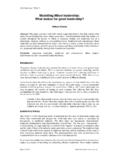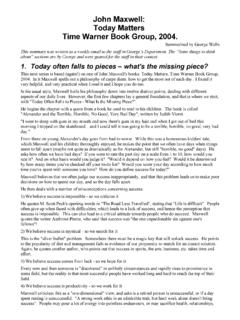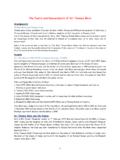Transcription of John Maxwell The 360-Degree Leader: Developing …
1 john MaxwellThe 360-Degree Leader: Developing your influence from anywhere in the Organization(Thomas Nelson, 2005)Summarised by George Wells Th is summary was writt en as a wee kly email to the staff in George s Department. Th e S ome things to t hink about sec tions are by George and were geared f or the staff in t heir context. In this book, Maxwell deals with an important topic: not everyone is called to be the top leader in an organisation, and so we need to learn to lead from "the middle". The idea of 360-Degree Leadership is that we should be able to "lead up", influencing our leaders , "lead across", influencing our peers, and "lead down", influencing those lower down the organisational hierarchy. As usual, Maxwell gets his points across with a series of fairly brief, pithy chapters dealing with various practical issues. He introduces the first section, which deals with myths about leadership, by reflecting on the sorts of people we instinctively think of when we think of "a leader": William Wallace, Winston Churchill, Mahatma Gandhi, etc.
2 He points out that this is misleading as "99% of all leadership occurs not from the top but from the middle of an organization". Taking this further, all of us can lead effectively, even if we're not the Vice Chancellor or the CEO. He notes that many people are good in one direction ( they have influence with their boss, but alienate the people who report to them, or are great with their team, but do no get along with their peers), and some people are very productive, but lack influence with anyone in the organization. In contrast, 360-Degree leaders have influence in all directions, with their superiors, with their peers and with their subordinates. While this may seem like a tall order, Maxwell provides some helpful guidelines in the book on how to lead in all three directions: up, across and down. He dedicates a section to each of these topics, but begins the book with a section that discusses a number of myths commonly believed about leading from the middle, followed by a second introductory section that discusses a number of challenges that middle leaders may face.
3 Myth #1: The Position Myth I cannot lead if I'm not at the top The perception that one cannot lead without a position or title is widely held, but not true in Maxwell 's opinion. As he states in "The 21 Irrefutable Laws of Leadership", "The true measure of leadership is influence - nothing more, nothing less". To counter this myth, Maxwell puts forward a hierarchy of leadership. At the lowest level is Position, where people follow you because they have to - this is leadership based on Rights. Level 2 is characterised by Permission, where people allow you to lead them - this is based on Relationship. Level 3 is the level of Production, where people follow you because of your achievements - based on Results. At level 4, the focus is on People Development, where people follow because of what you do for them - based on Reproduction. Lastly, the highest level of leadership is characterised by Personhood, where people follow you because of "who you are and what you represent" - based on Respect.
4 One starts at the bottom of this hierarchy with every person you interact with, and must earn the right to lead at higher levels. Using this hierarchy as a guideline, it is clear that one can lead without a significant position. Maxwell puts it this way: "Influencing others is a matter of disposition, not position". This can be done from anywhere in an organisation. In fact, middle leadership is vital for any organisation. Maxwell quotes David Branker, a long-standing and successful middle leader: "To do nothing in the middle is to create more weight for the top leader to leaders in the middle can have a profound effect on an organization". A closing quote, from Maxwell : Leadership is a choice you make, not a place you sit. Anyone can choose to become a leader wherever he is. You can make a difference no matter where you are. Some things to think about: 1) Can you think of any examples of middle leaders , who clearly exert an influence beyond the bounds of their position?
5 2) How would you rate your influence in all three directions (up, across and down)? We continue our introduction to the idea of 360-Degree Leadership, by considering the next few common myths that Maxwell finds are commonly held. Myth #2: The Destination Myth When I get to the top, then I'll learn to lead Maxwell opens this short chapter with a story about his writer, Charlie Wetzel. Charlie was a fairly keen recreational runner, who ran regularly and occasionally even competed in a 10km race. However, he had a goal of running a marathon, and decided in 2003 to run the Chicago marathon. Needless to say, he didn't just arrive in Chicago in October and run the race. His preparation and training was rigorous. This process started with the selection of the Chicago marathon. After much research he found that this was a relatively fast, flat route, with very dependable weather conditions, and great crowd support - in short, the ideal venue for a first attempt at a marathon.
6 He also researched how to run a marathon, using web sites, articles, chatting to marathon runners, etc. He even found someone with some experience of marathons who agreed to run with him in Chicago. Then he started to train (in April), increasing his weekly distance steadily. By October he was ready and easily completed the marathon. "Leadership is very similar. If you want to succeed, you need to learn as much as you can about leadership before you have a leadership position". Maxwell describes how people often tell him that they will read his books when they become leaders . He has to bite his tongue, and resist the temptation to tell them that they may not become leaders if they don't do some preparation! He strongly believes that leadership is learned by experience: one needs to seize any opportunities to develop leadership skills. "If you don't try out your leadership skills and decision-making process when the stakes are small and the risks low, you're likely to get into trouble at higher levels when the cost of mistakes is high, the impact is far reaching, and the exposure is greater".
7 He also quotes john Wooden, the famous basketball coach: "When opportunity comes, it's too late to prepare". One has to prepare for leadership ahead of time. Myth #3: The influence Myth If I were on top, then people would follow me Maxwell tells the story of a housekeeper who worked for President Woodrow Wilson. When she heard that the Secretary for Labour had resigned she suggested that her husband would be a good replacement - he worked hard and understood labour! Wilson pointed out that the cabinet position required someone of influence , to which she replied that if her husband was the Secretary for Labour then he would be influential! While few people would go as far as this woman, the idea that influence comes with position is commonly held. "You may be able to grant someone a position, but you cannot grant him real leadership. influence must be earned". Being given a position may give you an opportunity to establish some influence , but this will depend on how well you lead.
8 A good leader's influence will stretch beyond that conferred by the position. Conversely, a weak leader will end up with even less influence than their position would suggest. "[A] position doesn't make a leader, but a leader can make the position". Some things to think about: 1) How can one prepare for leadership before gaining a leadership position? 2) Can you think of any leaders who have acquired more influence than their position holds? Or conversely, of any leaders who have squandered the influence appropriate to their position? This week we look at the next two myths around the idea of 360-Degree Leadership, from Maxwell 's book (The 360-Degree Leader: Developing your influence from anywhere in the Organization). Myth #4: The Inexperience Myth When I get to the top, I'll be in control Maxwell notes that many people in any organisation will double-guess the leadership: "If I were in charge, we wouldn't have done Things sure would be different around here if I were the boss".
9 He notes that there is a positive aspect to such thinking - it demonstrates a desire to improve things, and is indicative of a leaning towards leadership. He quotes Andy Stanley on this issue: "If you're a leader and leaders work for you, they think they can do a better job than And that's not wrong; that's just leadership". However, there is also a negative aspect to such thoughts, as they are highly unrealistic. In practice, one often has less control, rather than more, as one ascends the organisational ladder. This is due to the numerous factors that potentially impact on the organisation, many of which are outside of any leader's control. Having real influence (rather than a title or position) is essential. As an example of this principle at work, he mentions Carly Fiorina, who was a very successful leader at Lucent, before being hired as the CEO of Hewlett-Packard. While at H-P, she managed the merger with Compaq, which was meant to put H-P in a strong position to compete with Dell.
10 However, the promise of the merger was not realised, and ultimately Fiorina was asked to leave. Although, she had the top position, she was not in control of the market factors that impacted on the merged company or, ultimately, of her own destiny. Myth #5: The Freedom Myth When I get to the top, I'll no longer be limited This is related in some ways to the previous myth, but focuses on the freedom that people believe they will have when they reach the top position in their organisation. Maxwell puts this idea into words: "When I get to the top, I'll have it When I'm in charge, the sky will be the limit". In practice, leaders are all subject to very real limits on what they can do. Many of these arise from the increased responsibilities and pressures that come with leadership positions. One has to weigh up the consequences of one's actions as a leader, and their impact on the organisation. The effect of this can be highly limiting. As an illustration, Maxwell considers a hypothetical, successful salesman.






